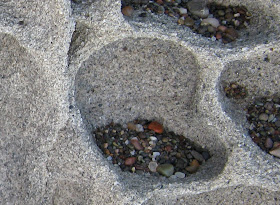 |
| Tafoni at Harmony Headlands State Park near Cayucos, California. |
Tafoni are common along the Central Coast of California. There were some at almost every beach I visited, though rock type and patterns varied. Tafoni formation frequently is attributed to salt-weathering. They are common in saline environments such as deserts and coastal zones, but not all coastal rock supports tafoni, and there are tafoni in other environments as well. Darn.
 |
| We found tafoni in a variety of sizes and shapes (click to view the little guys). |
 |
| Tafoni come and go. Note the softer lines of disappearing tafoni in the foreground. |
 |
| Harmony Headlands, nature geeks for scale. A short trail leads from a parking lot on Highway 1 to the coast. Photo courtesy J. G. LoCascio. |
Sometimes coastal tafoni are easy to explain. At least some of the cavities in the photo below are pholad holes, excavated by boring clams (members of the family Pholadidae) aka piddock clams, rock-eating clams or angel wings. Empty shells still occupy a few of the holes. The most common pholads of the area, Penitella penita, are thought to bore mainly by scraping with the ridged edges of their shells, sometimes as much as 4-5 cm per year. Other species resort to chemicals.
 |
| Tafoni, some with remains of boring clams, from Hazard Canyon Reef at Montaña de Oro State Park. The larger holes are ca 3 cm across. |
The abodes of boring clams have a distinctive shape -- narrower at the opening, like the darker hole on the right in the photo below. But are all these tafoni the same thing? Many of the larger ones widen upward, with concentric rings inside. Are these remnants of old pholad holes with the narrower upper part removed? How about the slight depressions scattered around the bigger holes? Are these incipient tafoni? or their last remains?
 |
| Pholad holes are common in some strata of the Monterey Formation at Hazard's. The area is accessible via the Hazard Canyon Trail in the north part of Montaña de Oro State Park. |
Did the tafoni on the left start as pholad holes, later enlarged by weathering and erosion? The regular pattern of irregular shapes, adjacent to fractures, is puzzling. Whatever the origins, Nature has worked her magic to produce enchanting rock art.
These tafoni are on the rock outcrop on the right edge of the photo below, at Moonstone Beach near Cambria.
A sampling of chert and other pebbles deposited by waves in tafoni at Moonstone Beach; pebbles are ca 0.5-1 cm across.







No comments:
Post a Comment